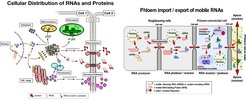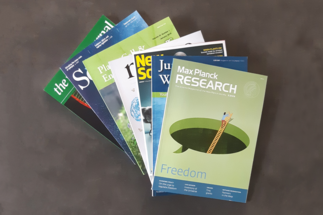Intercellular Macromolecular Transport

Distinct mRNAs and proteins expose motifs guiding them to distinct subcellular positions. Some of the mRNAs and proteins harbor selective motifs that mediate their delivery to adjacent and distant cells via intercellular pores named plasmodesmata and via the phloem. Plasmodesmata are channels forming a continuous cytoplasm and membrane system between connected cells called symplasm. They permit passive diffusion of small molecules and selective transport of large molecules via the cellulosic cell wall into the phloem and to distant plant cells.
The general aim is to understand the transport mechanism and the function of RNAs and proteins allocated via the vasculature of flowering plants. In plants it is well established that the phloem serves as system-wide delivery pathway for nutrients such as amino acids and sugars and growth regulating hormones. In the last decade this simple view was challenged by the discovery that via the phloem also specific subsets of RNA molecules are transported to distant tissues. Such phloem-delivered RNAs include messenger RNA (mRNA), transfer RNA (tRNA), tRNA halves, silencing-induced RNA (siRNA), and micro RNA (miRNA) that can act as long-distance signals regulating growth.

Notably, we uncovered that a surprisingly large fraction of nearly of approx. 20 % of protein encoding messenger RNAs are transported from shoot to roots and/or vice versa (Nature Plants, 2015). An analysis revealed that subsets of mobile mRNAs are specifically delivered to distinct tissues or are only transported under nutrient starvation conditions. We uncovered in subsets of mobile mRNAs an evolutionary conserved structure named tRNA like sequence that is necessary and sufficient to mediate transport. In addition, we found evidence that mRNAs are translated in functional proteins in receiving flower and root cells (The Plant Cell, 2016) and a secondary base modification (m5C methylation) (Current Biology, 2019) occur in the mobile mRNAs and allow their transport..
Plant Cell article

Identification of mobile mRNAs based on single nucleotide polymorphisms (SNPs) present in Arabidopsis Col and Ped ecotypes (Thieme et al, Nature Plants 2015). The two ecotypes were grafted and the mRNA present in shoots and roots of the chimeric plants were sequenced to identify ecotype specific mRNAs present in the heterologous tissue. Of 9.348 transcripts unambiguously assigned by SNPs to one of the two ecotypes 2.006 mRNAs were found in heterologous tissues indicading that they are transported over the graft junction to the scion or the root.

Detection of transport in grafted plants. A mobile mRNA was fused to a mRNA expressing a green fluorescent protein encoding non-mobile RNA. Presence of green fluorescence in the root tip of wild-type plants detected by confocal laser scanning microscopy indicates transport of either protein or mRNA or both to distant root tissue. Presence of RNA is confirmed in addition by RT-PCR and in situ detection assays.
In plants cell-to-cell transport of proteins and RNA molecules seems to be actively regulated depending on a number of cellular factors. Small heterologous proteins can diffuse non-selectively to neighboring cells whereas distinct endogenous- produced RNAs and proteins are actively selected for transport. Diffusion of small molecules is regulated by closing the plasmodesmatal pore by callose deposition, whereas actively transported macromolecules expose a transport motif that is recognized by cellular components facilitating delivery to neighboring cells via plasmodesmata. Despite these insights our knowledge is still limited regarding the structural features of protein and RNA transport motifs, interaction partners facilitating or regulating transport, the function of delivered RNAs in the receiving cells, and the identity of the distant cells receiving RNAs.

The transport mechanism and the transported macromolecules are addressed in the model plants A. thaliana, C. maximus (pumpkin), and Brassica (oilseed) plants using RNA-protein and protein-protein interaction assays (RIP, CoIP), large-scale single cell transcriptomics (scRNAseq), genome/transcriptome wide single nucleotide polymorphisms (SNPs) detection, RNA structure -function analysis, and high resolution 3D imaging for phenotyping and growth behavior.
Our main questions are:
- Which RNAs are transported to distant cells?
- What are the factors facilitating intercellular protein and mRNA transport?
- Are mobile messenger RNAs translated in receiving cells?
- What is the identity of cells producing and receiving mobile RNA?
- What is the signaling function of mobile proteins and RNAs?







